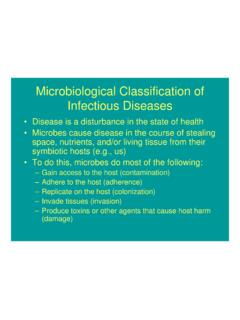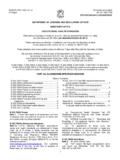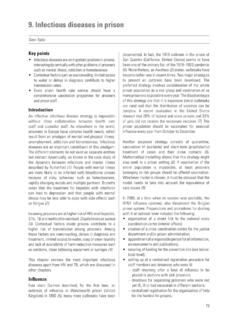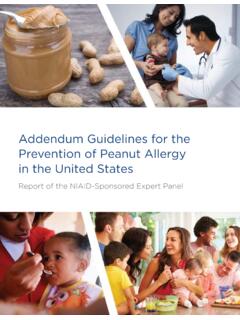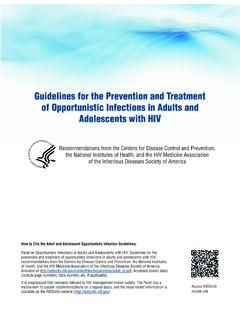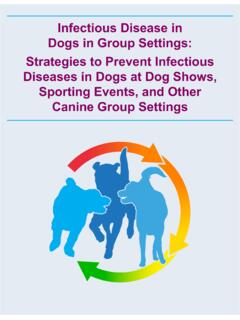Transcription of OSHA FACTSHEET BLOODBORNE PATHOGENS …
1 Implement the use of universal precautions(treating all human blood and OPIM as if knownto be infectious for BLOODBORNE PATHOGENS ). Identify and use engineering controls. Theseare devices that isolate or remove the blood-borne PATHOGENS hazard from the include sharps disposal containers, self-sheathing needles, and safer medical devices,such as sharps with engineered sharps-injuryprotection and needleless systems. Identify and ensure the use of work are practices that reduce thepossibility of exposure by changing the way atask is performed, such as appropriate practicesfor handling and disposing of contaminatedsharps, handling specimens, handling laundry,and cleaning contaminated surfaces and items. Provide personal protective equipment (PPE),such as gloves, gowns, eye protection, must clean, repair, andreplace this equipment as needed.
2 Provision,maintenance, repair and replacement are at nocost to the worker. Make available hepatitis B vaccinations to allworkers with occupational vac-cination must be offered after the worker hasreceived the required BLOODBORNE pathogenstraining and within 10 days of initial assignmentto a job with occupational exposure. Make available post-exposure evaluation andfollow-up to any occupationally exposed work-er who experiences an exposure incident is a specific eye, mouth,other mucous membrane, non-intact skin, orparenteral contact with blood or OPIM. Thisevaluation and follow-up must be at no cost tothe worker and includes documenting theroute(s) of exposure and the circumstancesProtections Provided by OSHA sBloodborne PATHOGENS StandardAll of the requirements of OSHA s BloodbornePathogens standard can be found in Title 29 of theCode of Federal Regulations at 29 CFR standard s requirements state what employ-ers must do to protect workers who are occupa-tionally exposed to blood or other potentiallyinfectious materials (OPIM), as defined in the stan-dard.
3 That is, the standard protects workers whocan reasonably be anticipated to come into con-tact with blood or OPIM as a result of doing theirjob duties. In general, the standard requires employers to: Establish an exposure control is awritten plan to eliminate or minimize occupa-tional exposures. The employer must preparean exposure determination that contains a listof job classifications in which all workers haveoccupational exposure and a list of job classifi-cations in which some workers have occupa-tional exposure, along with a list of the tasksand procedures performed by those workersthat result in their exposure. Employers must update the plan annually toreflect changes in tasks, procedures, and posi-tions that affect occupational exposure, andalso technological changes that eliminate orreduce occupational exposure.
4 In addition,employers must annually document in the planthat they have considered and begun usingappropriate, commercially-available effectivesafer medical devices designed to eliminate orminimize occupational exposure. Employersmust also document that they have solicitedinput from frontline workers in identifying, eval-uating, and selecting effective engineering andwork practice s BLOODBORNE PATHOGENS StandardBloodborne PATHOGENS are infectious microorganisms present in blood that cancause disease in humans. These PATHOGENS include, but are not limited to, hepatitis Bvirus (HBV), hepatitis C virus (HCV), and human immunodeficiency virus (HIV), thevirus that causes AIDS. Workers exposed to BLOODBORNE PATHOGENS are at risk forserious or life-threatening illnesses.
5 This is one in a series of informational fact sheets highlighting OSHA programs, policies or standards. It does not impose any new compliance requirements. For a comprehensive list of compliance requirements of OSHA standards or regulations, refer toTitle 29 of the Code of FederalRegulations. This information will be made available to sensory-impaired individuals upon voice phone is (202) 693-1999; the teletypewriter (TTY) number is (877) which the exposure incident occurred;identifying and testing the source individual forHBV and HIV infectivity, if the source individualconsents or the law does not require consent;collecting and testing the exposed worker sblood, if the worker consents; offering post-exposure prophylaxis; offering counseling; andevaluating reported illnesses.
6 The healthcareprofessional will provide a limited written opin-ion to the employer and all diagnoses mustremain confidential. Use labels and signs to communicate labels must be affixed to containers of regulated waste; containers of contaminatedreusable sharps; refrigerators and freezers containing blood or OPIM; other containersused to store, transport, or ship blood or OPIM;contaminated equipment that is being shippedor serviced; and bags or containers of con-taminated laundry, except as provided in thestandard. Facilities may use red bags or redcontainers instead of labels. In HIV and HBVresearch laboratories and production facilities,signs must be posted at all access doors whenOPIM or infected animals are present in thework area or containment module.
7 Provide information and training to must ensure that their workersreceive regular training that covers all elementsof the standard including, but not limited to:information on BLOODBORNE PATHOGENS and dis-eases, methods used to control occupationalexposure, hepatitis B vaccine, and medical eval-uation and post-exposure follow-up must offer this training on initialassignment, at least annually thereafter, andwhen new or modified tasks or proceduresaffect a worker s occupational exposure. Also,HIV and HBV laboratory and production facilityworkers must receive specialized initial training,in addition to the training provided to all work-ers with occupational exposure. Workers musthave the opportunity to ask the trainer ques-tions.
8 Also, training must be presented at aneducational level and in a language that work-ers understand. Maintain worker medical and training employer also must maintain a sharpsinjury log, unless it is exempt under Part 1904 --Recording and Reporting Occupational Injuriesand Illnesses, in Title 29 of the Code of InformationFor more information, go to OSHA s BloodbornePathogens and Needlestick Prevention Safety andHealth Topics web page at: f i l e a c o m p l a i n t b y p h o n e , r e p o r t a n e m e r g e n c y,or get OSHA advice, assistance, or products, con-tact your nearest OSHA office under the of Labor listing in your phone book, orcall us toll-free at (800) 321-OSHA (6742). Occupational Safetyand Health 1-800-321-6742 For assistance, contact can help.
9 It s 1/2011











